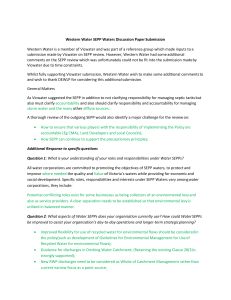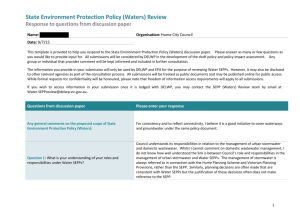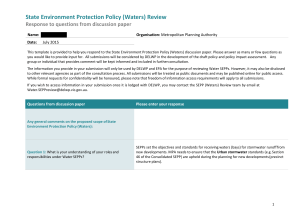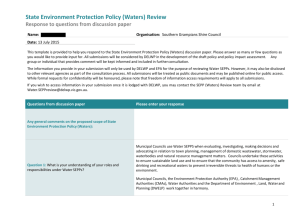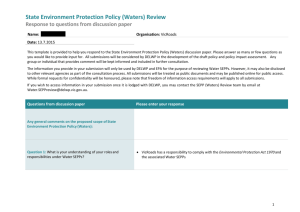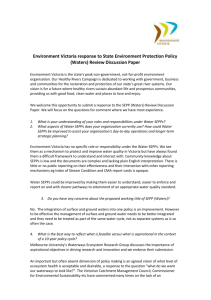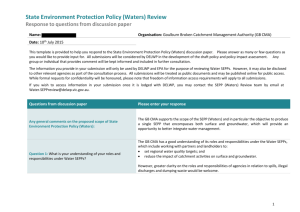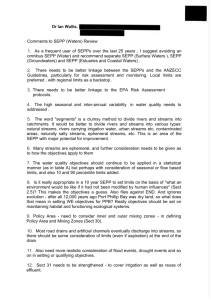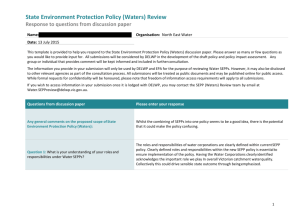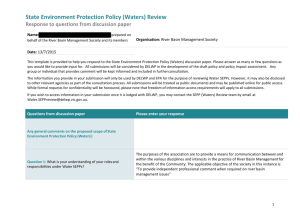GDF SUEZ Australian Energy (Accessible version)
advertisement
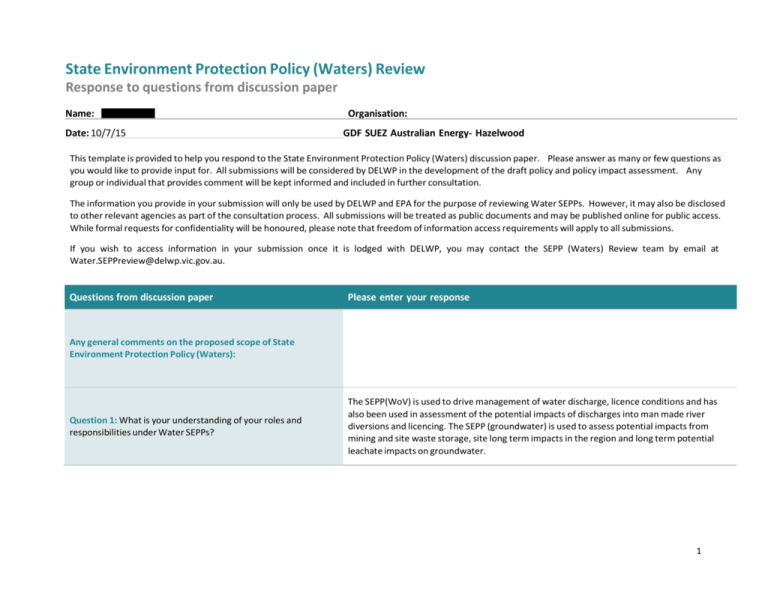
State Environment Protection Policy (Waters) Review Response to questions from discussion paper Name: Date: 10/7/15 Organisation: GDF SUEZ Australian Energy- Hazelwood This template is provided to help you respond to the State Environment Protection Policy (Waters) discussion paper. Please answer as many or few questions as you would like to provide input for. All submissions will be considered by DELWP in the development of the draft policy and policy impact assessment. Any group or individual that provides comment will be kept informed and included in further consultation. The information you provide in your submission will only be used by DELWP and EPA for the purpose of reviewing Water SEPPs. However, it may also be disclosed to other relevant agencies as part of the consultation process. All submissions will be treated as public documents and may be published online for public access. While formal requests for confidentiality will be honoured, please note that freedom of information access requirements will apply to all submissions. If you wish to access information in your submission once it is lodged with DELWP, you may contact the SEPP (Waters) Review team by email at Water.SEPPreview@delwp.vic.gov.au. Questions from discussion paper Please enter your response Any general comments on the proposed scope of State Environment Protection Policy (Waters): Question 1: What is your understanding of your roles and responsibilities under Water SEPPs? The SEPP(WoV) is used to drive management of water discharge, licence conditions and has also been used in assessment of the potential impacts of discharges into man made river diversions and licencing. The SEPP (groundwater) is used to assess potential impacts from mining and site waste storage, site long term impacts in the region and long term potential leachate impacts on groundwater. 1 State Environment Protection Policy (Waters) Review Response to questions from discussion paper Question 2: What aspects of Water SEPPs does your organisation currently use? How could Water SEPPs be improved to assist your organisation’s day-to-day operations and longer-term strategic planning? The current base indicators are a key focus on assessment not only of licence management but also on the potential environmental impact of those discharges. The indicators are used to assess where ongoing management or a change is needed to reduce potential for future environmental impact. Question 3: Do you have any concerns about the proposed working title of State Environment Protection Policy (Waters)? If so, what are they? No, the proposed title is fine Question 4: What is the best way to reflect what is feasible versus what is aspirational in the context of a 10-year policy cycle? Ensure major diffuse/background impacts (sources) are identified and focussed on for improvement. This should be dependent on the extent of any improvement that can be made and where it is warranted. Question 5: Do you support the proposed SEPP (Waters) objective of “this policy is to protect and improve the quality of Victoria’s waters while providing for economic and social development”? Why? Yes, 2010 Stream Index Condition assessment should allow focus on the main areas requiring improvement in controls and focus of the proposed SEPP. Question 6: Do you support the need to balance economic and social development with overall protection and improvement of water quality for Victoria’s water environments? Why? Yes, This is important, particularly that the 2010 Condition assessment shows many areas as poor (29 Yarra basin and many in the western side of the state). It’s important to balance economic and social development. An example is that even though basin 26 Latrobe is moderate, large industry and economic activity exists. Improving focus in other basins needs to balance the community values, social and economic viability of those areas and the state. 2 State Environment Protection Policy (Waters) Review Response to questions from discussion paper Question 7: What are the challenges of balancing economic and social development with protecting and improving water quality? How should we manage the appropriate trade-offs between them? It is not just the discharge or concentration rate in the stream, but the flow rates and the proportional inflow influences that are important to striking a balance. In some circumstances particular issues will need attention or direct controls, whilst management of flows proportional discharging can reduce immediate/potential impacts. Question 8: Do you foresee any problems or opportunities that may arise from creating one consistent SEPP to apply to all Victorian waters? Are there other options for streamlining the policies that we should consider? No, provided the current segments type management processes to differentiate concerns in a region are maintained and a targeted balanced improvements are implemented, taking in economic, social and environmental objectives Question 9: Are there any specific types of water environments, for example, a wastewater treatment lagoon, where you think beneficial uses should not be protected? Yes, artificial water ways, like cooling ponds, fire service dams, where these are used primarily for industrial purposes but may at times be accessible for recreational water activities. Other areas such as ash or tailing dams should also be excluded and the need for groundwater attenuation zones around these areas should be acknowledged. Question 10: Do you think the current measures for classifying surface water and groundwater segments are still appropriate? Are there other measures that should be explored? The current chemical physical measures for pH, TDS work well for industrial licencing and Nitrogen/phosphate indicators for diffuse systems are also of great benefit. Question 11: Are there any problems with the spatial arrangements or segment boundaries in the existing Water SEPPs? If so, what are they? Industrial zoning can have minor impacts, but should be identified and taken into account when establishing criteria. Often policies cause impact on licence conditions in the first instance as these are easily identified, compared to the larger issue of diffuse sources and their impacts. 3 State Environment Protection Policy (Waters) Review Response to questions from discussion paper Question 12: What do you think are the advantages or problems with the new approach to segments and sub-segments? Getting the right definition of the proposed segments and later the subsequent subsegments. The sub-segments should reflect the current/proposed objectives for that water source & activity, and recognise the economic and social aspects. Question 13: Are there any features of the landscape that you would like to see as a standalone segment or sub-segment? The figure 7 proposed segments & sub-segments map, omits the previous Latrobe Valley segment 26, which although it rates well on fig 2 “moderate basin health 2004-2010 is an important area for the state for both economic, social, surface water and groundwater aspects. Removing this segment may reduce the acknowledgment of the moderate rating indicated in the basin assessment Fig 2. The proposal to keep it as a sub-segment table 1 comparison is noted. Question 14: Do you believe that all beneficial uses set out in Table 2 of the discussion paper should still be protected under the new SEPP (Waters)? Where do you think a beneficial use would not apply? Why? Agriculture parks and gardens could be merged with agriculture and irrigation, and Human consumption after appropriate treatment could be merged potable water, given the advances in water treatment in the last 10-15 years. Alternatively potable could be renamed as Human consumption (no treatment). Question 15: What method or approach could be used to apply the beneficial uses to segments and sub-segments? This should take into account the stream condition assessments (Fig 2). The beneficial uses could be a sliding scale of improvement. Example some areas may achieve a level below what the current SEPP (WoV) sets as beneficial use. Ongoing improvement to reach a better outcome should be advanced where social, economic and environmental outcomes can be improved overall, dependant on the overall benefits. Question 16: Are there any additional beneficial uses that you believe should be protected? Are there any that you think should no longer be protected? Why? The aesthetics of water ways is a big social aspect on the feeling of wellbeing. The difference between an urban stormwater cannel and those of rural streams, lend themselves to a less than natural impression of water quality and environmental status. 4 State Environment Protection Policy (Waters) Review Response to questions from discussion paper Question 17: What do you think about the current indicators, the approach for deriving objectives and the proposed changes? The current indicators lend themselves to varied uses and applications of water ways and groundwater, as well as discharge and water quality indicators. This enables organisations to focus on specific or a range of indicators depending on the aspect under review. The approach of the focus on “urban” objectives, could be better explained as “developed” objectives, as urban lends itself to focus on residential rather than agricultural/industrial objectives. Question 18: How have nutrient load targets been useful in driving environmental investment outcomes? Would you like to see a different approach, and if so, what might that be? The concentration remains useful from a discharge management view for industrial purposes, and allows for comparison between objectives and licence discharge/river water quality results. The cap is useful for driving future impacts when reassessing a basin/sub-segment for future improvements. Question 19: What is the preferred method for management of at-risk areas? Are there activities that need greater intervention or regulation? What would the intervention be, for example, voluntary or mandatory codes of practice, regulation via licensing? Clear rules and guidelines are needed to enable open transparent assessments to be made and acknowledged. Although the EPA is identified in the text, the EPA manly only covers industrial licences, discharges and accident events that may occur. If the major problem is diffuse sources (section 1.5), then an appropriate agency needs to be identified as responsible for working with communities/agriculture etc. to drive improvement in the at risk areas. (EPA guidelines have helped). It is easy to target licenced discharges, but these are often well managed to minimise impact, whilst diffuse sources can be impacted by seasonal weather, stream flows and runoff from urban, regional and agricultural areas. Question 20: What do you think the role of SEPP (Waters) should be in identifying and filling knowledge gaps over the life of the policy? How can we assure an adaptive approach within SEPP (Waters)? Regional changes need to be assessed in light of the social, economic and environmental outcomes. Flexibility needs to support a sustainable way forward and the use of regional environmental management plans that take into account these sustainable goals is needed. Regional mechanisms derived to achieve regional outcomes that benefit all, allow for better balanced outcomes. Any other information you would like to share: It will be important over the life of the SEPP (waters) to engage at regional community levels. Not only to drive improvements or balance outcomes, but also to enable ongoing assessment and focus on beneficial uses for the long term benefit. 5

